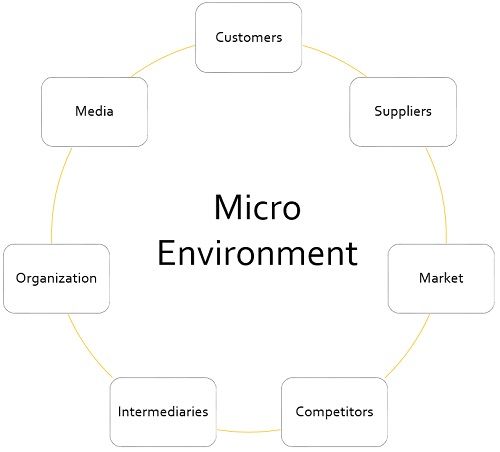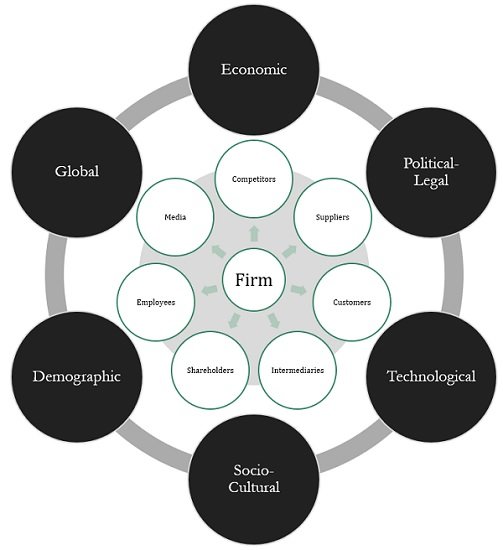Definition: External Environment refers to the part of the business environment which comprises all the outside elements or forces that affect the business operations. As a business cannot survive in isolation, it has to act or react effectively to every happening, just to keep the business going.
Therefore, the external environment has the capability of influencing the internal operations and objectives of the business and its strategies as well.
Types of External Environment
The external environment is divided into two categories:
Micro Environment
Microenvironment, as its name suggests, covers a very limited area and consists of all those components which can have a direct impact on the company’s operations. It indicates the immediate ambit of the organization, which can continuously influence or be influenced by the choices and decisions.
An alternative term for microenvironment is the task environment or operating environment.
- Customer: Customers are the persons or organizations who pay money, for buying the company’s product or services.
- Suppliers: A supplier can be a person or a firm that supplies raw materials, equipment, tools and services to the organization. The suppliers can affect the company’s cost structure with their bargaining power.
- Market: The place where the business operates, is called the market. Price sensitivity, market maturity, demand and supply forces, etc. can influence the business.
- Competitors: Competitors are rival organizations, which can be market leaders or followers. These are the firms that compete with the business entity for market share, resources, etc.
- Intermediaries: Intermediaries can be any party who serves as a bridge between the manufacturer and customer, such as departmental stores, online stores, retailers, etc.
- Organization: It covers the members of the organization such as shareholders, Board of Directors and employees, that has the capability of influencing the business.
- Media: Media is also one of the important elements these days which can make or break an organization. A positive public image is very important for increasing the customer base, while one negative comment can ruin the reputation of the company. Media also helps the company in promoting the company’s products and services.
Macro Environment
The macro-environment covers general factors, over which the organization has no control. It refers to the portion of the external environment which is purely external to the business entity.
The success of the firm depends on how well a company tunes itself with the dynamic macro environment. The strategies adopted by the firm can influence by the environment, and the changes in the macro environment can also influence the business operations to a great extent.
An alternative term for macro-environment is the general environment or remote environment.
Types of Macro Enviornment
- Demographic Environment: Demography indicates the characteristics of the population such as race, age, income, education, employment status, gender, etc. in a specific geographical area. The factors that can influence the business are sex ratio, educational attainment, geographic shifts in population, growth rate, ethnic mix, income distribution, etc.
- Technological Environment: Nowadays, technology is playing a key role in changing the lifestyle of human beings, by changing how they travel, communicate or do business. It can be an opportunity for a business firm if it can take advantage of the latest technological changes, or else it can be a threat. The factors can be emerging technologies, Research and Development, technological advancement, reduced communication costs, etc.
- Socio-Cultural Environment: In the socio-cultural environment, societal values, lifestyle, culture, social concerns, beliefs, traditions, the standard of literacy, role of women in society, ethical standards, social attitudes, etc. are some of the major factors that can have an impact over the business enterprise. These factors are common to all similar organizations.
- Political and Legal Environment: This environment is somewhat common to all similar firms and somewhat specific to the individual firm. It consists of three main components, i.e. government, legal and political. Political stability, law and order situation, level of political morality, the political ideology of the ruling party, corruption, bureaucracy, extent of government intervention in the industry, etc.
- Economic Environment: Economic environment encompasses the overall nature of the economy, in which the business operates and competes. Several factors in the economic environment can greatly affect how the business operates; these are economic conditions, economic system, globalization, economic change, inflation and interest rates, economic policies such as monetary and fiscal policy, Exim policy, industrial policy, etc.
A Word from Business Jargons
Hence, knowledge of the external environment can help in understanding the opportunities and threats to the business, which are very important for its survival, growth, expansion and profitability.


Leave a Reply